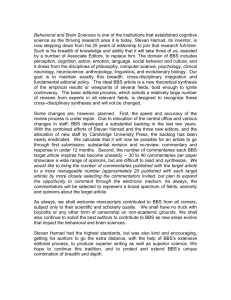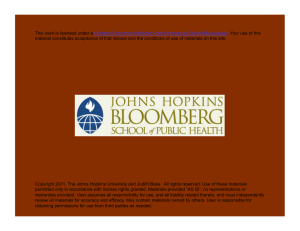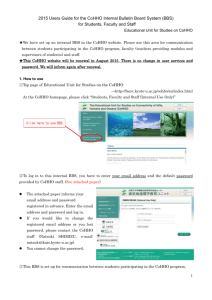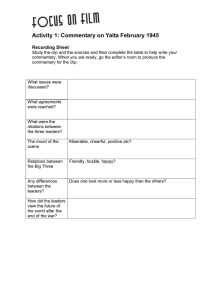Behavioral and Brain Sciences
advertisement
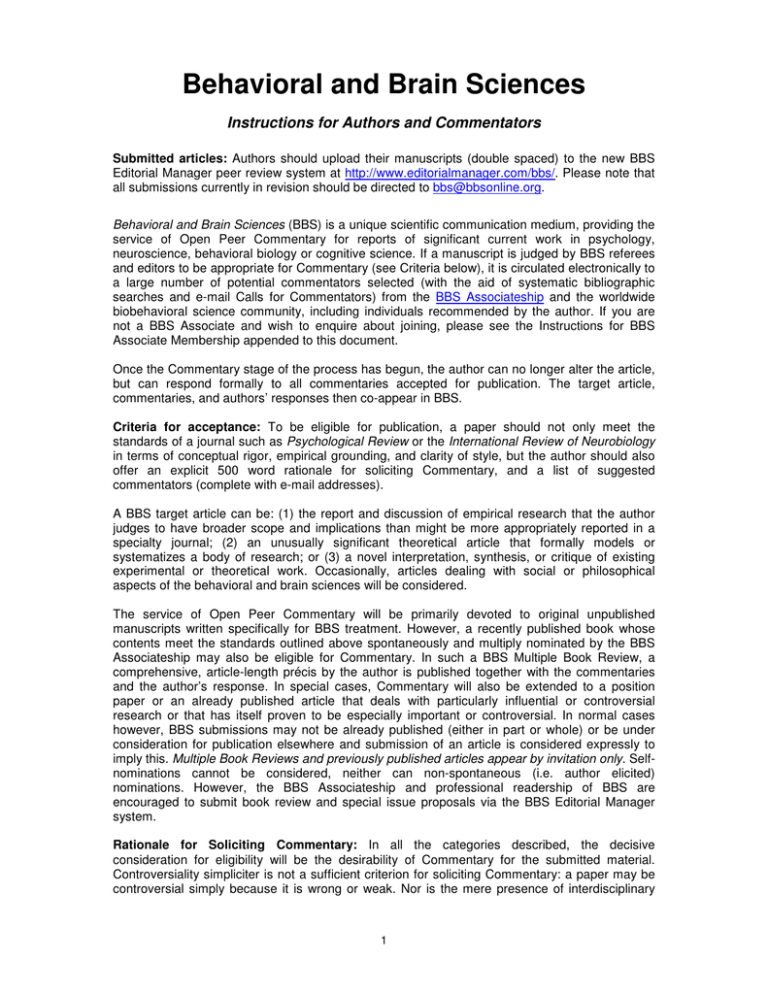
Behavioral and Brain Sciences Instructions for Authors and Commentators Submitted articles: Authors should upload their manuscripts (double spaced) to the new BBS Editorial Manager peer review system at http://www.editorialmanager.com/bbs/. Please note that all submissions currently in revision should be directed to bbs@bbsonline.org. Behavioral and Brain Sciences (BBS) is a unique scientific communication medium, providing the service of Open Peer Commentary for reports of significant current work in psychology, neuroscience, behavioral biology or cognitive science. If a manuscript is judged by BBS referees and editors to be appropriate for Commentary (see Criteria below), it is circulated electronically to a large number of potential commentators selected (with the aid of systematic bibliographic searches and e-mail Calls for Commentators) from the BBS Associateship and the worldwide biobehavioral science community, including individuals recommended by the author. If you are not a BBS Associate and wish to enquire about joining, please see the Instructions for BBS Associate Membership appended to this document. Once the Commentary stage of the process has begun, the author can no longer alter the article, but can respond formally to all commentaries accepted for publication. The target article, commentaries, and authors’ responses then co-appear in BBS. Criteria for acceptance: To be eligible for publication, a paper should not only meet the standards of a journal such as Psychological Review or the International Review of Neurobiology in terms of conceptual rigor, empirical grounding, and clarity of style, but the author should also offer an explicit 500 word rationale for soliciting Commentary, and a list of suggested commentators (complete with e-mail addresses). A BBS target article can be: (1) the report and discussion of empirical research that the author judges to have broader scope and implications than might be more appropriately reported in a specialty journal; (2) an unusually significant theoretical article that formally models or systematizes a body of research; or (3) a novel interpretation, synthesis, or critique of existing experimental or theoretical work. Occasionally, articles dealing with social or philosophical aspects of the behavioral and brain sciences will be considered. The service of Open Peer Commentary will be primarily devoted to original unpublished manuscripts written specifically for BBS treatment. However, a recently published book whose contents meet the standards outlined above spontaneously and multiply nominated by the BBS Associateship may also be eligible for Commentary. In such a BBS Multiple Book Review, a comprehensive, article-length précis by the author is published together with the commentaries and the author’s response. In special cases, Commentary will also be extended to a position paper or an already published article that deals with particularly influential or controversial research or that has itself proven to be especially important or controversial. In normal cases however, BBS submissions may not be already published (either in part or whole) or be under consideration for publication elsewhere and submission of an article is considered expressly to imply this. Multiple Book Reviews and previously published articles appear by invitation only. Selfnominations cannot be considered, neither can non-spontaneous (i.e. author elicited) nominations. However, the BBS Associateship and professional readership of BBS are encouraged to submit book review and special issue proposals via the BBS Editorial Manager system. Rationale for Soliciting Commentary: In all the categories described, the decisive consideration for eligibility will be the desirability of Commentary for the submitted material. Controversiality simpliciter is not a sufficient criterion for soliciting Commentary: a paper may be controversial simply because it is wrong or weak. Nor is the mere presence of interdisciplinary 1 aspects sufficient: general cybernetic and “organismic” disquisitions are not appropriate for BBS. Some appropriate rationales for seeking Open Peer Commentary would be that: (1) the material bears in a significant way on some current controversial issues in behavioral and brain sciences; (2) its findings substantively contradict some well established aspects of current research and theory; (3) it criticizes the findings, practices, or principles of an accepted or influential line of work; (4) it unifies a substantial amount of disparate research; (5) it has important crossdisciplinary ramifications; (6) it introduces an innovative methodology or formalism for broader consideration; (7) it meaningfully integrates a body of brain and behavioral data; (8) it places a hitherto dissociated area of research into an evolutionary or ecological perspective; etc. In order to assure communication with potential commentators (and readers) from other BBS specialty areas, all technical terminology must be clearly defined or simplified, and specialized concepts must be fully described. In case of doubt of appropriateness for BBS commentary, authors should submit a target article proposal via the BBS Editorial Manager system. A note on commentaries: The purpose of the Open Peer Commentary service is to provide a concentrated constructive interaction between author and commentators on a topic judged to be of broad significance to the biobehavioral science community. Commentators should provide substantive criticism, interpretation, and elaboration as well as any pertinent complementary or supplementary material, such as illustrations; all original data will be refereed in order to assure the archival validity of BBS commentaries. Commentaries and articles should be free of hyperbole and remarks ad hominem. Please follow the BBS Instructions for Commentators on pages 4-5. Style and format for target articles: Target Articles must not exceed 14,000 words (and should ordinarily be considerably shorter); commentaries should not exceed 1,000 words, excluding references. Spelling, capitalization, and punctuation should be consistent within each article and commentary and should follow the style recommended in the latest edition of A Manual of Style, The University of Chicago Press. It is advisable to examine a recent issue of BBS as a model. Target articles should be submitted (double spaced) MSWord or RTF format to the new BBS Editorial Manager peer review system at http://www.editorialmanager.com/bbs/. Please note that all submissions currently in revision should be directed to bbs@bbsonline.org. Figures should appear in the body of the text, not at the end of the paper, and must be supplied as separate TIFF, EPS, JPEG, or GIF files. However, if your article is accepted, TIFF or EPS format will be requested for publication since printing requires resolutions of at least 1100 dpi. (Please note that costs for color figure reproduction will be passed along to the author. Color printing is expensive, and authors are encouraged to find alternative methods for presentation of their argument.) Please make sure your target article file has ALL of the following in this order: Four Separate Word Counts (for the abstract, main text, references, and entire text—total + addresses etc.), an Indexable Title, Full Name(s), Institutional Address(es), E-mail Address(es) and Homepage URL(s) for all authors (where available), Short Abstract (100 words), Long Abstract (250 words), 5-10 Keywords (in alphabetical order), approx. 12,000 word Main Text (with paragraphs separated by full blank lines, not tab indents), and Alphabetical Reference List. Target article authors must also provide numbered headings and subheadings to facilitate cross-reference by commentators. Tables and figures (i.e., photographs, graphs, charts, or other artwork) should be numbered consecutively and should appear in its appropriate location. Every table should have a title; every figure, a caption. Endnotes and appendices should be grouped together at the end of the paper and should ideally be locally linked to in the text to facilitate the reader (and of course the referee’s task). Acknowledgements should be placed at the end of the paper. The short abstract will appear on the back cover of the journal by way of an advertisement, one issue in advance of the publication issue. The long abstract will be circulated to referees and then potential commentators should the paper be accepted, and will appear with the printed article. BBS’s rigorous timetable constraints (requiring the coordination of target articles, commentaries and author’s responses within the publishing queue) make it extremely difficult for us to process 2 follow-up drafts of your submission. Please make sure that the paper you submit is the carefully checked final draft which you wish the referees to address. Please also ensure that your submission has been proofread by a native English speaker before submission. This, of course, greatly improves its chances at the refereeing stage. References: Bibliographic citations in the text must include the author’s last name and the date of publication and may include page references. Complete bibliographic information for each citation should be included in the list of references. Please also include and link to the URL for any paper for which it exists. Examples of correct styles are: Brown (1973); (Brown 1973); Brown 1973; 1978); (Brown 1973; Jones 1976); (Brown & Jones 1978); (Brown et al. 1978). References should be in alphabetical order in the style of the following examples. Do not abbreviate journal titles: Freeman, W. J. (1958) Distribution in time and space of prepyriform electrical activity. Journal of Neurophysiology 2:644-66. http://cogprints.soton.ac.uk/abs/neuro/199806009 Dennet, D. C. (1991) Two contrasts: Folk craft versus folk science and belief versus opinion. In: The future of folk psychology: Intentionality and cognitive science, ed. J. D. Greenwood, [page numbers]. Cambridge University Press. http://cogprints.soton.ac.uk/abs/phil/199804005 Bateson, P. P. G. & Hinde, R. A., eds. (1978) Growing points in ethology. Cambridge University Press. Editing: The publishers reserve the right to edit and proof all articles and commentaries accepted for publication. Authors of target articles will be given the opportunity to review the copyedited manuscript and page proofs. Commentators will be asked to review copyediting only when changes have been substantial; commentators will not see proofs. Both authors and commentators should notify the editorial office of all corrections within 48 hours of receipt of proofs or approval will be assumed. If your target article is accepted, the pre-copyedited final draft will be archived publicly for potential commentators. The copyedited final draft will only be available for the invited commentators. Authors of target articles receive free offprints of the entire treatment, and can purchase additional copies. Commentators will also be given an opportunity to purchase offprints of the entire treatment. Author response to commentaries: All invited commentaries received before the deadline are posted as they are received and are only accessible to the Authors and Editors. Please note that no commentary is officially accepted until the Editor in charge has formally reviewed it and notified both the authors and editorial staff. Please follow exactly the BBS Commentary Response Instructions before submitting your response. 3 Behavioral and Brain Sciences Instructions for Commentators COMMENTARIES ARE DUE FIVE (5) WEEKS FROM DATE OF INVITATION General Information: Behavioral and Brain Sciences (BBS) is a unique scientific communication medium, providing the service of Open Peer Commentary for reports of significant current work in psychology, neuroscience, behavioral biology or cognitive science. If a manuscript is judged by BBS referees and editors to be appropriate for Commentary (see Criteria below), it is circulated electronically to a large number of commentators selected (with the aid of systematic bibliographic searches and email Calls for Commentators) from the BBS Associateship and the worldwide biobehavioral science community, including individuals recommended by the author. If you are not a BBS Associate and wish to enquire about joining, please see the instructions for associate membership. Once the Commentary stage of the process has begun, the author can no longer alter the article, but can respond formally to all commentaries accepted for publication. The target article, commentaries, and authors' responses then co-appear in BBS. The purpose of the BBS Open Peer Commentary service is to provide a concentrated constructive interaction between authors and commentators on a topic judged to be of broad significance to the biobehavioral science community. Commentators should provide substantive criticism, interpretation, and elaboration as well as any pertinent complementary or supplementary material, such as illustrations; all original data will be refereed in order to assure the archival validity of BBS commentaries. Commentaries and articles should be free of hyperbole and remarks ad hominem. Commentary articles appear by invitation only. Please follow these instructions before submitting your invited commentary. Commentators must be BBS Associates or be nominated by a BBS Associate. Please refer to the Instructions for BBS Associate Membership at the end of this document. General Format of Commentaries: Accepted commentaries received in time will be copublished with the target article and the authors' response. (Please note that although commentaries are solicited and most will appear, they are subject to editorial review and acceptance cannot be guaranteed in advance.) Please do not devote the limited space in your commentary to repeating the contents of the accompanying target article. Portions of commentaries redundant with the target article or with other accepted commentaries may have to be deleted by the editor. BBS also reserves the right to edit commentaries for relevance and style. In the interests of speed, commentators will only be sent the edited copy for review when there have been major editorial changes. (All commentaries are editorially reviewed; where necessary, they may also be formally refereed.) Please provide an informative, indexable title for your commentary. As many commentators will address the same general topic, your title should be a distinctive one that reflects the gist of your specific contribution and that is suitable for the kind of keyword indexing used in modern bibliographic retrieval systems. With many active commentary invitations at any one time, it is also extremely helpful to us if you indicate at the very top of your commentary the name of the target-article authors on whom your are commenting. (There is no need to cite the entire target article, just the name of the authors.) 4 Step by Step Guide to Required Commentary Format: Editorial Manager is now the medium by which BBS transfers and processes all of its material, from the first draft of the target article, through open peer commentary, to the author's response and final publication. We now no longer process new submissions via email attachments to the editorial office. Invited commentaries can only be accepted in the following format: A. MSWord or RTF file submitted through the new BBS Editorial Manager peer review system at http://www.editorialmanager.com/bbs/. B. FIGURES may be in JPEG, GIF, TIFF or EPS format. However, TIFF or EPS format may be required for publication. C. All figures, tables and equations must be placed where you would like them to appear in print, at the proper location in the document with the corresponding figure captions below (or above the tables). In addition, please make sure your commentary has ALL of the following in this order: 01. THE NAME OF THE AUTHOR(S) OF THE TARGET ARTICLE 02. FOUR SEPARATE WORD COUNTS (ABSTRACT, MAIN TEXT, REFERENCES, ENTIRE TEXT (TOTAL + ADDRESSES etc.) 03. AN INDEXABLE AND INFORMATIVE COMMENTARY TITLE 04. FULL NAME(S) 05. INSTITUTION 06. FULL INSTITUTIONAL MAILING ADDRESS(S) 07. INSTITUTIONAL TELEPHONE NUMBER(S) (for correspondence) 08. ONE EMAIL ADDRESS EACH 09. ONE HOME PAGE URL EACH (where available) 10. 60 word ABSTRACT 11. 1000 word MAIN TEXT (with paragraphs separated by full blank lines, NOT tab indents) 12. ALPHABETICAL REFERENCE LIST (APA STANDARD) Except for BBS Special Issues, commentaries should be no more than 1000 words. Special Issue commentators are permitted an extra 400 words for each additional commentary on which they write (i.e. a commentary on three Special Issue papers would have a limit of 1000 + 400 + 400 = 1800). BBS's rigorous timetable constraints (requiring the coordination of target articles, commentaries, and authors' responses within the publishing queue) make it extremely difficult for us to process follow-up drafts of your commentary submission. Please make sure your commentary is the carefully checked final draft which you wish the authors to respond. Small non-substantive corrections, not affecting the author's response, are possible at a later stage, when you are sent the edited copy to review. Please also ensure that your submission has been proofread by a native English speaker before submission. 5 Behavioral and Brain Sciences Commentary Response Instructions AUTHOR RESPONSE TO COMMENTARIES ARE DUE FIVE (5) WEEKS FROM THE COMMENTARY SUBMISSION DEADLINE All submitted commentaries on your target article will only be accessible to the Authors and Editors. Please note that even though all commentaries are posted, no commentary is officially accepted until the Editor in charge has formally reviewed it and notified both you and the Editorial Coordinator that it has been accepted. This will be done after the grace period for late commentaries has expired. We invite you to use the interval until the final commentary acceptance to begin to compose your response, with the caution that some commentaries may be rejected, some may undergo substantial editing, and some may be added right up until the final date. In addition, you may feel that some of the commentaries should not be accepted for some reason (e.g., quality, relevance) or should perhaps have particular sections scrutinized by the Editor. You are encouraged to communicate any such concerns to the Editor, but with the understanding that the final decision must rest with BBS. Organization of the formal Response: Clearly, the authors must be allowed the liberty to express and defend themselves as they see fit, but out of consideration for the reader (who must assimilate all this material), and in order to derive benefit from BBS experience so far, we make the following suggestions: (a) The multiple commentaries, appearing alphabetically rather than in terms of subject matter, present the reader with the problem of integration. Optimally, this should be provided by the author's formal response. Many authors have found it useful to organize their responses around specific topics that have suggested themselves in the commentary. A table classifying the commentaries according to these topics as well as informative section headings has often been found to be most useful. In addition, any general and integrative observations that suggest themselves are very helpful to the reader and help to place the author back in the central locus that he is meant to occupy in an Open Peer Commentary. A serene tone is best; do not trade barbs. Rather than matching the tone of a response you find intemperate, personal or offensive, notify the Editor of your concerns as described above. (b) The commentaries tend to place the reader in a position of waiting for the other shoe (or, more properly, shoes) to drop. It is highly advisable therefore not to leave any specific nontrivial queries or criticisms unanswered. We would ask that you cite every commentary at least once, for example, to rebut some specific claim, to answer with an extended argument, or simply to classify it into a set of responses raising similar points. (c) The response should provide an integration and an overview. It should avoid becoming a haphazard pastiche of replies to random points, but it is nevertheless important that specific replies should be addressed to specific commentators. To aid the reader in cross-referring, you should put the first instance of any commentator's name in each paragraph of the response in boldface. This way the reader impatient to hear a particularly profound shoe drop can cross-refer directly from the commentary he is reading to a quick scan of the response to determine whether the author has replied to his satisfaction. In summary, the optimally organized response will represent an appropriate balance, integrating the general themes in the commentaries and providing specific, thorough replies to the substantive points made, each point prominently identified by indicating the names of the commentators who made them. 6 The preferred length of a BBS Response is about 8-12,000 words; it should not exceed half the length of the target article. Please supply a distinctive and representative (keyword-indexable) title and an abstract of approximately 60 words, summarizing as specifically as possible the content of your contribution. Style and Format for the Response to Commentaries: A. Your response be submitted in MSWord or RTF format. B. Figures may be in JPEG, GIF, TIFF or EPS format. Depending on the quality of the images, TIFF or EPS format may be required. C. All figures, tables and equations must be placed where you would like them to appear in print, at the proper location in the document with the corresponding figure captions below (or above the tables). Authors should upload their response articles (double spaced) to the new BBS Editorial Manager peer review system at http://www.editorialmanager.com/bbs/. Please note that all submissions currently in revision should be directed to bbs@bbsonline.org. 7 Behavioral and Brain Sciences Instructions for BBS Associate Membership Eligibility "Eligibility" usually means being an academically trained professional contributor to one of the disciplines mentioned earlier, or to related academic disciplines. The email should indicate the candidate's general qualifications as well as their basis for wishing to serve as commentator for the particular target article in question. It is preferable also to enclose a Curriculum Vitae. The following are eligible to become BBS Associates: ● Anyone who has had a target article accepted for publication in BBS ● Anyone who has had a commentary accepted for publication in BBS ● Anyone who has refereed for BBS ● Anyone who has been nominated by a current BBS Associate If a current BBS Associate is familiar with your work, please approach that Associate directly to request nomination, or, if you prefer, we can do it for you (please specify the Associate's name and email address). A list is available at the following URL: http://www.bbsonline.org/Instructions/assoclist.html If no current BBS Associate knows your work, please send us your Curriculum Vitae and BBS will circulate it to appropriate Associates to ask whether they would be prepared to nominate you. (In the meantime, your name, address and email address will be entered into our database as an unaffiliated investigator.) Please email calls@bbsonline.org for all BBS Associate correspondence. Updated 10/30/2008 8
